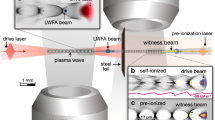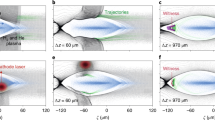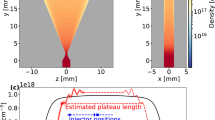Abstract
Plasma-based accelerators driven by either intense lasers1 or charged particle beams2 can accelerate electrons or positrons with extremely high gradients compared with conventional radio-frequency accelerators. For their use as next-generation light sources and in energy frontier colliders3, beams with good stability, high quality, controllable polarization and excellent reproducibility4,5 are required. The accelerated electrons can be either internally injected directly from the background plasma or externally injected from conventional accelerators. Despite significant progress6,7,8,9,10,11,12,13,14, the beam properties obtained with the internal injection scheme fall short of simultaneously reaching these requirements. In contrast, such high-property beams are routinely generated from conventional accelerators. Therefore, it is important to demonstrate the injection from a conventional accelerator into a plasma-based machine followed by further acceleration of the beam. Here we report the demonstration of external injection from a conventional linear accelerator into a laser wakefield accelerator and subsequent acceleration without any significant loss of charge, which is achieved by properly shaping and matching the beam into the plasma structure. The experimental results, combined with three-dimensional particle-in-cell simulations, indicate that this is possible with modest degradation in the beam quality. This work is an important step towards realizing a high-throughput, multistage, high-energy, hybrid conventional-plasma-based accelerator.
This is a preview of subscription content, access via your institution
Access options
Access Nature and 54 other Nature Portfolio journals
Get Nature+, our best-value online-access subscription
$29.99 / 30 days
cancel any time
Subscribe to this journal
Receive 12 print issues and online access
$209.00 per year
only $17.42 per issue
Buy this article
- Purchase on Springer Link
- Instant access to full article PDF
Prices may be subject to local taxes which are calculated during checkout




Similar content being viewed by others
Data availability
Source data are provided with this paper. All other data that support the plots within this paper and other findings of this study are available from the corresponding authors upon reasonable request.
Code availability
The codes that support the findings of this study are available from the corresponding authors upon reasonable request.
References
Tajima, T. & Dawson, J. M. Laser electron accelerator. Phys. Rev. Lett. 43, 267–270 (1979).
Chen, P., Dawson, J. M., Huff, R. W. & Katsouleas, T. Acceleration of electrons by the interaction of a bunched electron beam with a plasma. Phys. Rev. Lett. 54, 693–696 (1985); erratum 55, 1537 (1985).
Ritz, S. et al. Building for Discovery: Strategic Plan for U.S. Particle Physics in the Global Context (The Particle Physics Project Prioritization Panel (P5): Subpanel of the High Energy Physics Advisory Panel (HEPAP), 2014); http://www.usparticlephysics.org/p5/
Schroeder, C. B., Esarey, E., Geddes, C. G. R., Benedetti, C. & Leemans, W. P. Physics considerations for laser-plasma linear colliders. Phys. Rev. ST Accel. Beams 13, 101301 (2010).
Adli, E. et al. A beam driven plasma-wakefield linear collider: from Higgs factory to multi-TeV. Preprint at https://arxiv.org/abs/1308.1145 (2013).
Faure, J. et al. A laser–plasma accelerator producing monoenergetic electron beams. Nature 431, 541–544 (2004).
Geddes, C. G. R. et al. High-quality electron beams from a laser wakefield accelerator using plasma-channel guiding. Nature 431, 538–541 (2004).
Mangles, S. P. D. et al. Monoenergetic beams of relativistic electrons from intense laser–plasma interactions. Nature 431, 535–538 (2004).
Blumenfeld, I. et al. Energy doubling of 42 GeV electrons in a metre-scale plasma wakefield accelerator. Nature 445, 741–744 (2007).
Corde, S. et al. Multi-gigaelectronvolt acceleration of positrons in a self-loaded plasma wakefield. Nature 524, 442–445 (2015).
Adli, E. et al. Acceleration of electrons in the plasma wakefield of a proton bunch. Nature 561, 363–367 (2018).
Steinke, S. et al. Multistage coupling of independent laser-plasma accelerators. Nature 530, 190–193 (2016).
Litos, M. et al. High-efficiency acceleration of an electron beam in a plasma wakefield accelerator. Nature 515, 92–95 (2014).
Maier, A. R. et al. Decoding sources of energy variability in a laser-plasma accelerator. Phys. Rev. X 10, 031039 (2020).
Clayton, C. E. et al. Ultrahigh-gradient acceleration of injected electrons by laser-excited relativistic electron plasma waves. Phys. Rev. Lett. 70, 37–40 (1993).
Everett, M. et al. Trapped electron acceleration by a laser-driven relativistic plasma wave. Nature 368, 527–529 (1994).
Amiranoff, F. et al. Electron acceleration in Nd-laser plasma beat-wave experiments. Phys. Rev. Lett. 74, 5220–5223 (1995).
Jin, Z. et al. Coupling effects in multistage laser wake-field acceleration of electrons. Sci. Rep. 9, 20045 (2019).
Luo, J. et al. Multistage coupling of laser-wakefield accelerators with curved plasma channels. Phys. Rev. Lett. 120, 154801 (2018).
Xu, X. L. et al. Physics of phase space matching for staging plasma and traditional accelerator components using longitudinal tailored plasma profiles. Phys. Rev. Lett. 116, 124801 (2016).
Dornmair, I. et al. Emittance conservation by tailored focusing profiles in a plasma accelerator. Phys. Rev. ST Accel. Beams 18, 041302 (2015).
Du, Y. et al. Generation of first hard X-ray pulse at Tsinghua Thomson Scattering X-ray source. Rev. Sci. Instrum. 84, 053301 (2013).
Zheng, L. et al. Development of S-band photocathode RF guns at Tsinghua University. Nucl. Instrum. Methods Phys. Res. 834, 98–107 (2016).
Wang, X. J., Qiu, X. & Ben-Zvi, I. Experimental observation of high-brightness microbunching in a photocathode rf electron gun. Phys. Rev. E 54, R3121–R3124 (1996).
Lin, Z. et al. Development of sub-100 femtosecond timing and synchronization system. Rev. Sci. Instrum. 89, 014701 (2018).
Fonseca, R. A. et al. OSIRIS: a three-dimensional, fully relativistic particle in cell code for modeling plasma based accelerators. Lect. Notes Comput. Sci. 2331, 342–351 (2002).
Esarey, E., Schroeder, C. B. & Leemans, W. P. Physics of laser-driven plasma-based electron accelerators. Rev. Mod. Phys. 81, 1229–1285 (2009).
Tilborg, J. et al. Active plasma lensing for relativistic laser-plasma-accelerated electron beams. Phys. Rev. Lett. 115, 184802 (2015).
Yoon, S. J., Palastro, J. P. & Milchberg, H. M. Quasi-phase-matched laser wakefield acceleration. Phys. Rev. Lett. 112, 134803 (2014).
Cowley, J. et al. Excitation and control of plasma wakefields by multiple laser pulses. Phys. Rev. Lett. 119, 044802 (2017).
Wang, J. W., Schroeder, C. B., Li, R., Zepf, M. & Rykovanov, S. G. Plasma channel undulator excited by high-order laser modes. Sci. Rep. 7, 16884 (2017).
Flöttmann, K. ASTRA: a space charge tracking algorithm (DESY, 2017); http://www.desy.de/~mpyflo
Zhang, L. & Zhuang, J. Calculation of two-screen emittance measurement. Nucl. Instrum. Methods Phys. Res. 407, 356–358 (1998).
Chanteloup, J.-C. Multiple-wave lateral shearing interferometry for wave-front sensing. Appl. Opt. 44, 1559–1571 (2005).
Lifschitz, A. F. et al. Particle-in-cell modelling of laser–plasma interaction using Fourier decompostion. J. Comput. Phys. 228, 1803–1814 (2009).
Davidson, A. et al. Implementation of a hybrid particle code with a PIC description in r − z and a gridless description in ϕ into OSIRIS. J. Comput. Phys. 281, 1063–1077 (2015).
Martins, S. F. et al. Exploring laser-wakefield-accelerator regimes for near-term lasers using particle-in-cell simulation in Lorentz-boosted frames. Nat. Phys. 6, 311–316 (2010).
Martins, S. F. et al. Numerical simulations of a laser wakefield accelerators in optimal Lorentz frames. Comput. Phys. Comm. 181, 869–875 (2010).
Acknowledgements
This work is supported by the National Natural Science Foundation of China (NSFC) grants (no. 11535006, no. 11991071, no. 11775125 and no. 11875175), CAS Center for Excellence in Particle Physics, the US Department of Energy grants (no. DE-SC0010064, no. DE-SC0008491 and no. DE-SC0008316) and the US National Science Foundation (NSF) grant no. 1734315. The simulations were performed on Sunway TaihuLight and Cori cluster at National Energy Research Scientific Computing Center (NERSC).
Author information
Authors and Affiliations
Contributions
W.L. conceived and supervised the project. J.H. led the development of laser system, plasma structure and diagnostics. Y.D. led the optimization of electron beam. Y.W., Z.Z., S.L., B.P., J.H., Y.D. and W.L. performed the experiments. Y.W. analysed the experimental data and carried out the corresponding simulations. W.L., C.J., Y.W. and J.H. wrote the paper. All the authors contributed extensively to the work presented in this paper.
Corresponding authors
Ethics declarations
Competing interests
The authors declare no competing interests.
Additional information
Peer review information Nature Physics thanks John Palastro, Paramel Pattathil and the other, anonymous, reviewer(s) for their contribution to the peer review of this work.
Publisher’s note Springer Nature remains neutral with regard to jurisdictional claims in published maps and institutional affiliations.
Extended data
Extended Data Fig. 1 Experimental cases for non-matched injection.
a, The measured energy-dispersed beam distributions, with zf = −1.5 mm and np = 6 × 1017 cm−3. b, The integrated normalized beam charge corresponding to panel a (20-plasma-off-shot average for each plasma-on shot), where the error bars represent the standard deviation.
Extended Data Fig. 2 Simulation results for different relative delays.
The simulated energy-dispersed beam distributions as a function of the relative delay between the electron beam and the laser, with zf = −4.5 mm and np = 6 × 1017 cm−3. Here the relative delay of 0 fs corresponds to the absolute delay as shown in Fig. 3d.
Extended Data Fig. 3 Simulation results obtained by increasing the beam charge.
a, The simulated angle-resolved energy-dispersed beam distributions obtained by increasing the beam charge Q from 20 fC to 1 pC and 2pC, while keeping other parameters invariant, with zf = −3.5 mm and np = 6 × 1017 cm−3. b, The corresponding energy spectra. c, The corresponding evolutions of the normalized beam emittance.
Extended Data Fig. 4 Simulation results for high energy gain when using a longer plasma and a more powerful laser.
The plasma has a 2.4 mm-long up-ramp identical to the experimental condition as the matching section, and a 20 cm-long plateau as the acceleration section (see panel a). A 200 TW laser is focused to a spot size w0 = 35 μm with a0 = 2.2 at the beginning of the plateau (z = 2.4 mm). The plasma transverse profile is set to a parabolic channel \(n_{p,0} \times \left( {1 + 0.4 \times \frac{{x^2 + y^2}}{{w_0^2}}} \right)\) for laser guiding, where np,0 is the on-axis density with the plateau value of 2 × 1017 cm−3. A 50 pC, 25 MeV, 10 fs full duration (flat-top current profile) electron beam with 0.6% FWHM (no chirp) energy spread and 1 mm mrad normalized emittance is focused to z = 0 with a transverse waist size of 4 μm r.m.s. (left inset in panel a). The matching section can transport the beam from this waist to another waist with spot size of ~1.5 μm r.m.s. and energy of ~50 MeV at z = 2.4 mm (right inset in panel a), which is nearly matched to the plasma focusing fields in the acceleration section. b, The simulated Ez at z = 2.4 mm (upper half) and z = 93.6 mm (lower half). The blue and red lines show the lineouts of on-axis Ez values for z = 2.4 mm and z = 93.6 mm, respectively. The electron beam is first over-loaded (blue line), and then as the beam phase slips forward the wake, the longitudinal field within the beam is gradually flattened (red line). After that, the beam is under-loaded. The green and yellow lines show the contours of the laser (e−2 of its peak intensity) and the electron beam (full bunch length in ξ and r.m.s. spot size in x), respectively. c, Evolutions of the beam r.m.s. spot size (green line), normalized emittance (blue line) and central energy (red line). The shaded regions correspond to the beam r.m.s. energy spread (times 5 for visual clarity). d, The final beam longitudinal phase space.
Extended Data Fig. 5 Ultrashort electron beam generation and transport.
a, The schematic layout of the high-brightness S-band LINAC beamline at Tsinghua University. b, The simulated beam current profile (charge 20 fC) using the code ASTRA according to the experimental settings, where the beam head locates at the right.
Supplementary information
Supplementary Information
Transverse beam dynamics and characterization of the plasma structure.
Source data
Source Data Fig. 1
Source data for Fig. 1c.
Source Data Fig. 2
Source data for Fig. 2f–o.
Source Data Fig. 3
Source data for Fig. 3a–f,h.
Source Data Fig. 4
Source data for Fig. 4.
Source Data Extended Data Fig. 1
Source data for Extended Data Fig. 1b.
Source Data Extended Data Fig. 3
Source data for Extended Data Fig. 3b,c.
Source Data Extended Data Fig. 4
Source data for Extended Data Fig. 4b,c.
Source Data Extended Data Fig. 5
Source data for Extended Data Fig. 5b.
Rights and permissions
About this article
Cite this article
Wu, Y., Hua, J., Zhou, Z. et al. High-throughput injection–acceleration of electron bunches from a linear accelerator to a laser wakefield accelerator. Nat. Phys. 17, 801–806 (2021). https://doi.org/10.1038/s41567-021-01202-6
Received:
Accepted:
Published:
Issue Date:
DOI: https://doi.org/10.1038/s41567-021-01202-6
This article is cited by
-
Novel approach to push the limit of temporal resolution in ultrafast electron diffraction accelerators
Scientific Reports (2022)



